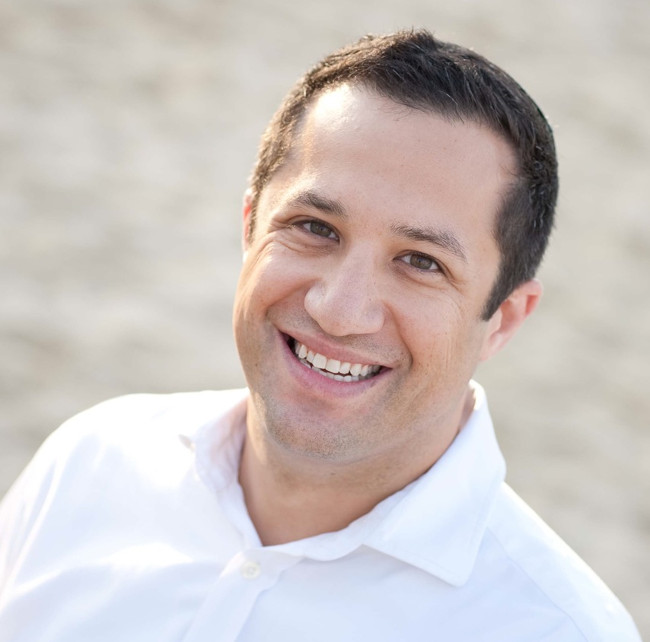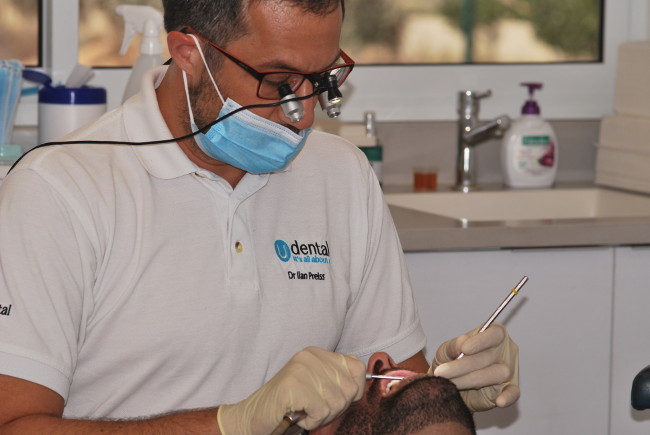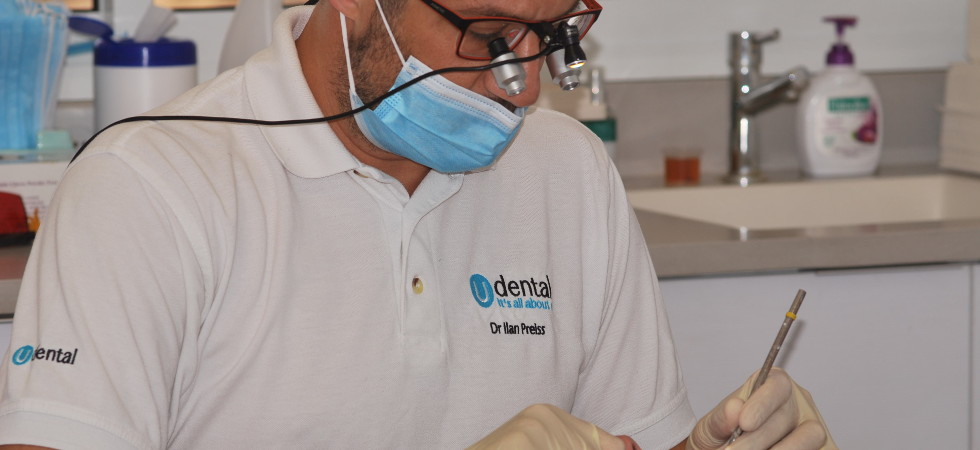By Eve Glover
Dr. Ilan Preiss is a two-time UK National Smile award winner and international lecturer on digital and cosmetic dentistry. He works at clinics in the UK and Israel. As a patient of Dr. Preiss’, I can attest to how thorough and detailed he is. He always takes extended time to explain in depth the details of each procedure. His love and enthusiasm for dentistry, coupled with the genuine concern he has for his patients make him a truly exceptional dentist and person.
What made you decide to become a dentist?
My father was a dentist. I saw him at work and witnessed the joy it gave him, so I always had a particular interest in the field. Both my sister and my brother went to study dentistry, so it’s quite a family affair. In addition, I was looking for a career where I could be artistic, as well as run a business and provide a health care element, so dentistry seemed to fit and tick all the boxes.
Were you always a cosmetic dentist?
No. After I finished dental school, I went into general dentistry for one year. I quickly realized that for me, the more exciting side of dentistry was the artistic side, which requires a lot more postgraduate learning. I set out on a journey of learning from the best cosmetic dentists around the world. I travelled to Brazil, and all across America and Europe. I learned some of the basics behind cosmetic dentistry, and discovered a real passion and love for both the science and art behind it.

What are the most requested cosmetic dental procedures?
Tooth whitening – people are always keen to have a brighter, whiter smile, and adult orthodontics, meaning braces for people over the age of 21
How long have you been working at Bow Lane Dental Group? What types of treatments are offered there? Where in London is it located?
I have been an associate at Bow Lane Dental clinic for 15 years now. Bow Lane is situated in the heart of the city of London where the banks are located. It has six surgical operatories and is employed by top specialists such as orthodontics, periodontics, root canal specialists, and implant specialists. We focus on minimal intervention dentistry and cosmetic dentistry.
We do the least amount of work necessary to create the best results for your teeth. Long term, this means we preserve as much of the tooth as we can so that minimal damage is done with maximal results. In addition, we have added a new technology to the clinic which enables us to offer an impression free service. That means no more sticky moulds placed in the mouth. We use digital images to construct any crown and mill the crown on site. Everything can be completed in one hour instead of having to wait two weeks. Thousands of happy patients have been treated at Bow Lane.
Please tell us about U Dental. What treatments do you offer that set it apart from other dentistry practices in Israel? How did you come up with that name?
I opened my Israel clinic five years ago. I wanted to provide not only high quality techniques and treatment, but also a high quality service to go with that. The name U Dental came about because essentially it’s all about you. What it means is that I will treat my patients as if I am treating my own mouth, or any member of my family’s mouth. I will always make sure that the patient is aware of every treatment option, every treatment cost. My staff and I treat all of our patients with care and respect, and with their best interests at heart. U Dental is the only licensed dentistry practice in Israel to use Durathin veneers.
What are Durathin Veneers made of and how do they work?
Durathin veneers are a type of ultra thin porcelain veneers (.2mm of thickness). They are created by using a technique developed by Dennis Wells, a dentist in Nashville, Tennessee, who I studied under. The Durathin veneer is a very technique sensitive and highly technical treatment, but if used correctly, is incredibly conservative in terms of there being very minimal drilling down of the teeth, or in some suitable cases, no drilling at all. That is a fantastic advantage for the patient.
What is the difference between a composite veneer and a Durathin veneer?
The answer to that question is essentially the same as asking what the difference is between a composite veneer and a porcelain veneer. The main difference is that composite veneers are generally designed and created in the mouth by the dentist chairside, while you are there, and porcelain veneers are created by taking a model of your teeth, sending it to technicians, and then a laboratory ceramist designs and builds a smile.
With regards to the material differences, porcelain is generally able to achieve a higher polish, and is easier to create a better smile, but the main advantage to using porcelain veneers is because they last longer. Composite is a material that is a little more porous than porcelain, so it can stain more easily over time. However, in the last two to three years big developments have been made to composite veneers that are making these negatives less and less relevant.
How long are Durathin Veneers expected to last?
I have studied occlusion for many, many years. Occlusion is the art of how the teeth bite. I make sure to choose very specific places for these Durathin veneers, to allow for longevity and ensure that there is no breakage of these beautiful pieces of art. Many dentists can offer ultra thin veneers, but the key to ensuring that they last is to choose a dentist who has results that can back up 10-15 years with no breakages.
Cosmetic dentistry is an art form and highly individualized. Much like plastic surgery, there is no one size fits all approach. What factors do you take into consideration when deciding what types of veneers will look best for that patient’s teeth, bone structure, etc. Do you take before and after photos – what do you do to assess?
When we start the journey for a new smile using veneers, we always take a series of photographs of the patient, put them on the screen, and ask the patient what their expectations are to find out what they are looking for. We make sure what they want to achieve is realistic and something that will be a good fit for their smile. We take into account factors such as gender, skin tone, face shape, lip size, nose size, to help us to find to the most aesthetically pleasing veneers for that individual patient. When we decide on the colour, shape, and length of the veneers, all of these factors are taken into account.
We take photographs, then models of the teeth, then x-rays. We design a smile physically in the laboratory. We show the end result like you would show a model of a building if you were an architect. We’re also able to do a digital smile design. Using computer programs, we can show a 3D design of how a patient’s new teeth are going to look. We take this model and transfer it into the patient’s mouth, taking photographs along the way and showing them exactly how it will look in their actual mouth and with their smile. We always ask our patients for their opinions every step of the way.
Once the patient has started the process of veneers, they usually have a temporary phase for one to two weeks to get used to them. During that time they provide us with as much feedback as they like, which we pass on to the technician to make sure that the veneers fit them perfectly and that the aesthetic fits that patient’s unique desires. It is always a joint team effort.

For adults whose teeth have shifted and for obvious reasons don’t want to sport the look of conventional braces, what is available to straighten teeth and bring them back into alignment?
The two main methods for straightening teeth in the most cosmetic way are by using Invisalign and fixed lingual braces, such as Incognito. Invisalign is a system developed in America and it has been used on over four million patients to date. It involves a series of plastic retainers that are changed every one to two weeks that slowly align the teeth. Invisalign is a fantastic system in that the retainer is removable, so it makes it easier to brush your teeth. It is also removed during eating and drinking, so it doesn’t disturb any issues that come up with chewing with regular braces. But on the flip side, the patient needs to have the motivation as well as desire to keep it in their mouth for the treatment to work.
The second cosmetic way to straighten teeth is with fixed lingual braces, such as Incognito. These are low profile gold based brackets that are attached to the inside of your teeth so that the visibility of any treatment is kept to a bare minimum. The downsides are that it can disturb speech a little bit initially, and cleaning is a little more difficult. The main drawback is that cost is usually double or even triple that of regular braces.
There is another alternative treatment, which uses a removable brace that is slightly visible, but it works extremely quickly. It’s called the Inman Aligner, which was developed in America by an orthodontic technician by the name of Dawn Inman. It works on the front four to six teeth of either the upper or lower jaw, and in anything from six to 14 weeks, the patient could be completed with their treatment. To summarize, you can either opt for clear retainers using Invisalign, or you can go for inside braces using Incognito, or you can choose the Inman Aligner, which is less aesthetic, but the treatment works at an incredibly rapid pace.
Do you see people more sociable and confident as a result of a transformed smile? This must be a big reason why you do what you do.
When we carry out a smile makeover, it is one of the most rewarding things for me in dentistry to see the change in confidence in your patients. A lot of patients come into my clinic shy, covering their mouth, not wanting to smile, and at the end of the treatment, such as a full whitening or braces or veneers, they leave wanting to show off their smile. It’s a well known fact that smiling, happy people give off a much more positive and confident attitude and aura than people who cover their smiles or are too embarrassed to smile. All the letters, gifts, thanks and praise we receive is the reason we do our job. The joy we get from seeing confidence in a patient motivates us to do what we do. The most common thing a patient will say after getting a smile makeover is that they wished they had done it sooner.






















